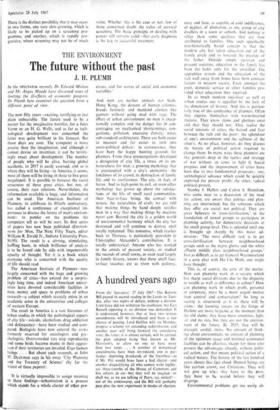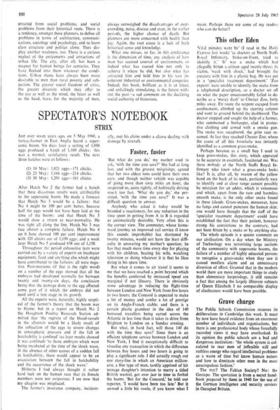The future without the past
THE ENVIRONMENT J. H. PLUAIB
In the SPECTATOR recently Dr Edward Mishan and Mr Angus Maude have discussed ways of limiting the ill-effects of economic progress. Dr Plumb here examines the question from a different point of view.
The next fifty years—exciting, terrifying or just plain unbearable. The future used to be a matter for the imaginative novelist, for a Jules Verne or an H. G. Wells, and as far as tech- nological development was concerned the latter was quite brilliant in his forecast. But those days are over. The computer is more precise than the imagination, and although it cannot devise an invention, it can be terrify- ingly exact about development. The number of people who will be alive, barring global accidents, in 2017 is easily assessed, and so is where they will be living—in America, it seems, most of them will be living in three to five great megalopoli. It is possible to forecast the racial structures of these great cities, but not, of course, their race relations. Nevertheless, the information available is huge, and information can be used. The American Institute of Planners, to celebrate its fiftieth anniversary, has called a conference of exceptional im- portance to discuss the future of man's environ- ment: to ponder on the problems the computers tell us will be ours. Its first series of papers has now been published (Environ- ment for Man, The Next Fifty Years, editor William R. Ewald Jr., Indiana University Press, $6.95). The result is a stirring, stimulating, baffling book, in which brilliance of analysis is to be found side by side with impenetrable opacity of thought. Yet it is a book which everyone who is concerned with the quality of life should read.
The American Institute of Planners—now largely concerned with the huge and growing problem of cities—has existed for a surpris- ingly long time, and indeed American univer- sities have devoted considerable facilities in men, money and space to problems of urban research—a subject which scarcely exists in an academic sense in the universities and colleges of western Europe.
The result in America is a vast literature of urban studies in which the pathological aspects of city life—suicide, alcoholism, drug addiction and delinquency—have been studied and com- pared. Biologists have now entered the arena formerly reserved for sociologists and psy- chologists. Overcrowded rats stop reproducing and some birds become manic in their aggres- sion if their territories are invaded. Ergo human beings . . . But about such research, as John W. Dyckman says in his essay 'City Planning and the Treasury of Science' (by far the wisest of these papers):
`It is virtually impossible to assign meaning to these findings—urbanisation is a process which stands for a whole cluster of other pro- cesses, and for scores of social and economic variables.'
And men are neither animals nor birds. Hong Kong, the densest of human colonies, breeds furiously and mankind clusters like gannets without going mad with rage. The effect of urban environment on man is excep- tionally complex and the danger lies in con- centrating on mechanical shortcomings, con- gestions, pollution, excessive density, noise, sub-standard architecture. These are both easier to measure and far easier to turn into socio-political debate: in consequence, they have been the happy hunting grounds for planners. From these preoccupations developed a derogation of city life, a stress on its un- naturalness for man, a growing mythology that is preoccupied with a city's anonymity--the loneliness of its crowd, its destruction of family life and its rootlessness. The city, in fact, of Satan. And to high-point its evil, an even sillier mythology has grown up about the satisfac- tions of the life of small rural communities. their face-to-face living, the contact with nature, the naturalness of craft; we are told that making things by hand deeply satisfies man in a way that making things by machine never can. Beyond the city is a golden world of environmental harmony which the city has destroyed and will continue to destroy until totally replanned. This nonsense, which reaches back to Thoreau, is particularly prevalent in Christopher Alexander's contribution. It is totally unhistorical. Anyone who has worked in the annals of peasant society, or studied the records of small towns, or even read largely in family history, knows that these small face- to-face societies are as riven with jealousy. envy and hate, as capable of cold indifference, of neglect, of alienation, as any group of city dwellers in a town or suburb. And nothing is sillier than some qualities that are now attributed to families. One such specifically non-historically based concept is that the modern city has taken education out of the family circle and so lowered The prestige of the father. Outside simple agrarian and peasant societies, education in the family has been the habit only for the unskilled. The apprentice system and the education of the rich well away from home have been constant factors in western society. Even amongst the poor, domestic service in other families pro- vided what education they received.
In so much modern sociology as well as urban studies one is appalled by the lack of the dimension of history. And this is particu- larly true of this conference of planners. Often they express themselves with warm-hearted rhetoric. They know slums and ghettoes exist and that they should not. They realise the social tensions of cities, the hatred and fear between the rich and the poor: the splendour of one's environment and the ugliness of the other's. At no place, however, do they discuss the nature of political action required to change them. In many ways these planners are like generals deep in the tactics and strategy of war without an army to fight it. Social progress and the improvement of cities have been due to two fundamental processes: one, technological advance which could be quickly exploited for private profit; the other, radical political protest.
Stanley J. Hallett and Calvin S. Hamilton, who come near to a discussion of the need for action, are aware that politics and plan- ning are intertwined, but the solutions which they offer are social, not political. They are great believers in 'cross-fertilisation,' in the foundation of mixed groups to participate in planning activity, for democratic decisions at the small group level. This is splendid until one is brought up sharply by this naive ad- mission: The most difficult task is to get cross-fertilisation between neighbourhood groups such as the negro ghetto and the white affluent middle class neighbourhood groups.' Just as difficult as to get General Westmoreland in a cosy chat with Ho Chi Minh, one might have thought.
This is, of course, the core of the matter. How can planning work in a society which has sharp social divisions due to the disparity in wealth as well as difference in colour? How can planning work in which profit, personal or corporate, must be a more urgent motive than control and conservation? So long as society is structured as it is, there will be slums: the looming towers on the fringe of Harlem are more hygienic at the moment than the old slums: they have more amenities, light, air and no rats, but they are not the environ- ment of the future. By 2025, they will be decrepit, sordid, slums. No amount of think- ing about environment, no amount of planning of the optimum space and minimal communal facilities can be effective, except for those who possess the advantages already, without politi- cal action, and that means political action of a radical nature. The history of the last hundred years shouts that fact aloud. Human beings are like carrion crow?, not Christians. They will not give up wh2 t they have to the poor, they have to Ix: scared before they will disgorge.
Environmental problems get too easily ab- stracted from social problems, and social problems from their historical roots. There is a tendency, amongst these planners, to define all problems in terms of architecture, communi- cations, sociology and psychology, and to leave class structure and politics alone. They dis- play another weakness, too. There is a curious neglect of the enticements and attractions of urban life. The city, after all, has been a magnet for human beings for centuries. They have flocked into them whatever the condi- tions. Urban slums have always been more desirable to men than rural poverty and sub- jection. The greater social freedom of cities, the greater diversity which they offer to the eye as well as the mind, the heart as well as the head, have, for the majority of men, always outweighed the disadvantages of over- crowding, noise, disease and even, in the earlier periods, the higher chance of death. But planners are more concerned with health than joy. Again, the root cause is a lack of both historical sense and knowledge.
What one misses, so far, in this conference is the dimension of time, any analysis of how man has secured control of environment, or indeed what has caused him not only to achieve it where he did, but also what has attracted him and held him in his vast in- coherent industrial or environmental congeries. Indeed, this book, brilliant as it is at times, and unfailingly stimulating, is the future with- out the past—a sad comment on the declining social authority of historians.































 Previous page
Previous page